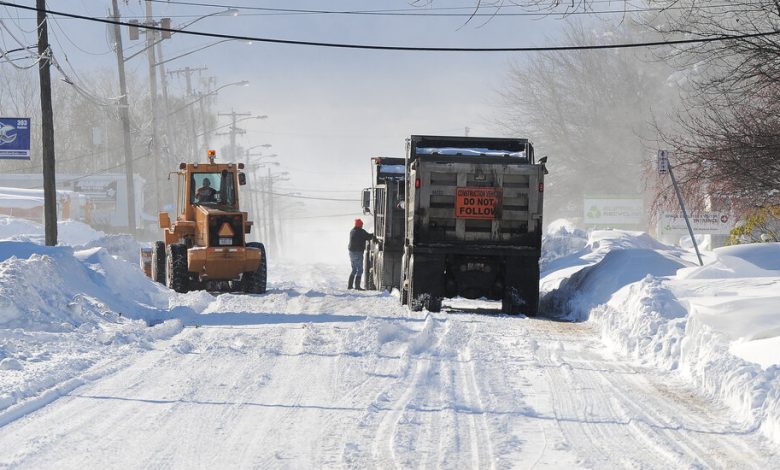‘Nothing Like a Buffalo Winter’: Residents Undaunted by 6 Feet of Snow

Buffalo seemed largely unfazed Sunday even as bad weather lingered after one of the biggest winter storms in recent state history dumped more than six feet of snow on the city, with intense winds triggering whiteout conditions that shut the region down.
As the storm began to abate Sunday morning, emergency response officials rushed to clear roads during a break in the snowfall, which was expected to return overnight at a much calmer pace, accumulating by less than two inches. After that, no more snow is expected through Thanksgiving.
The National Weather Service said the storm dropped a record amount of snow for the region in a 24-hour period — 21.5 inches on Saturday. The previous record was 7.6 inches on Nov. 19, 2014, during a storm that left more than 86 inches by its third day. This has been the area’s second-snowiest November on record, with 36.9 inches.
Still, many Buffalo residents took the storm in their stride. John D’Aquino, 23, a law student at the University at Buffalo, trudged through the snowbanks to get a cup of coffee from a local shop before walking back to his apartment to watch the Buffalo Bills game. The street where he lives was unplowed, with several vehicles on the shoulder of the road still encased in snow.
“There’s nothing like a Buffalo winter,” Mr. D’Aquino said.
Mark C. Poloncarz, the Erie County executive, said during a news conference Sunday morning that much of the region had already been cleared of snow, and that a driving ban on some of the worst-hit roads could be lifted within two days. He said the county has become much more nimble in dealing with weather events, noting that after a similar storm in 2014 many county roads were closed for a week.
Read More About Extreme Weather
- Reversing Course: The Netherlands, a country long shaped by its overabundance of water, is suddenly confronting drought. Its population is hoping to engineer its way to safety.
- Drying Out: The Mississippi River, known for its vast reach and powerful currents, has withered to levels not seen in decades, choking shipping lanes and endangering drinking water supplies.
- Smoke Pollution: Smoke from wildfires has worsened over the past decade, potentially reversing decades of improvements in Western air quality made under the Clean Air Act, according to new research.
“At this point eight years ago, we were just basically finishing up with the snow, and we really hadn’t gotten to recovery efforts and cleanup efforts yet,” Mr. Poloncarz said. “And here we are, eight years later, with having had more snowfall in a shorter time period in most of the areas that were affected, and we are much better along.”
Some school district officials were even contemplating holding classes as usual on Monday. Lisa Chimera, the deputy county executive, said superintendents held a meeting Sunday morning over Zoom to consider their options, though several have already chosen to close schools.
The storm was blamed for killing two people “as a result of snow-blowing, snow-shoveling issues,” Mr. Poloncarz said, urging residents to be careful when clearing driveways and encouraging them to check on neighbors. There were 280 people rescued in the area, and some 1,600 without power. Five buildings collapsed under the weight of snow, the Weather Service said.
The storm, which dumped up to five inches per hour at times, left the biggest overall total in Orchard Park, a suburb southeast of Buffalo — exactly 80 inches, or more than six and a half feet. Although the Weather Service has not determined if the storm broke any statewide records, county officials believe snow totals will exceed the storm of 1966, when 50 inches fell on Oneida County in a day. Unconfirmed reports on Saturday suggested more than that amount fell in Orchard Park on Friday.
The more recent snowfall has been powdery and easier to clear, but expected wind gusts could create drifts that limit visibility. Crews are also struggling to break through densely packed snow and ice beneath the surface.
On a sunny day in the town of Amherst north of Buffalo, winds whipped clouds of snow off the top of the roof outside a local hockey rink and across the parking lot below.
As people in this suburban community continued to clean up driveways and vehicles from the storm, many of the main roadways were completely cleared.
“I like the snow. I like Buffalo weather,” said Lany Mankowski, a retired federal government employee who was watching her 10-year-old grandson play hockey inside the Northtown Center at Amherst on Sunday. “People just take it in stride.”
A few miles away on Buffalo’s Main Street, roads were covered with slush, and many people were still digging their way out.
Gov. Kathy Hochul, a Democrat and Buffalo native, declared a state of emergency for 11 counties, including some adjacent to Lake Ontario in New York’s northern border with Canada. During a news conference on Sunday, Ms. Hochul said she had asked federal emergency officials for help paying for recovery efforts. She said she also plans to ask for federal aid for small businesses that were hurt by the storm.
“As someone who’s from Buffalo and has lived in upstate my entire life, we’ve seen a lot of snow,” Ms. Hochul said. “But when you hit 80 to 85 inches over the course of, you know, just a couple-of-day snow event, everywhere from Natural Bridge up in the North Country to Orchard Park, that is one to tell your grandkids about.”
Elijah Cap, 21, an accounting student at the University at Buffalo who works part time at a supermarket, missed his 6 a.m. shift because he was buried in too deeply. He said the storm was “pretty average” by the city’s standards.
“I don’t think it was anything crazy,” Mr. Cap said. “Main Street is always a mess in the winter.”
